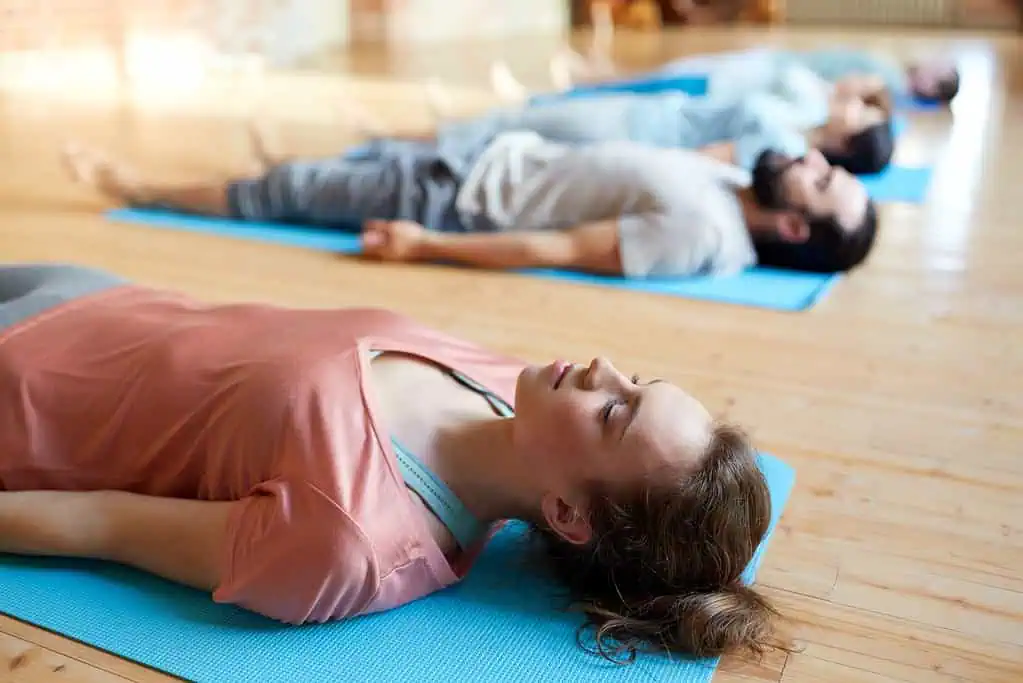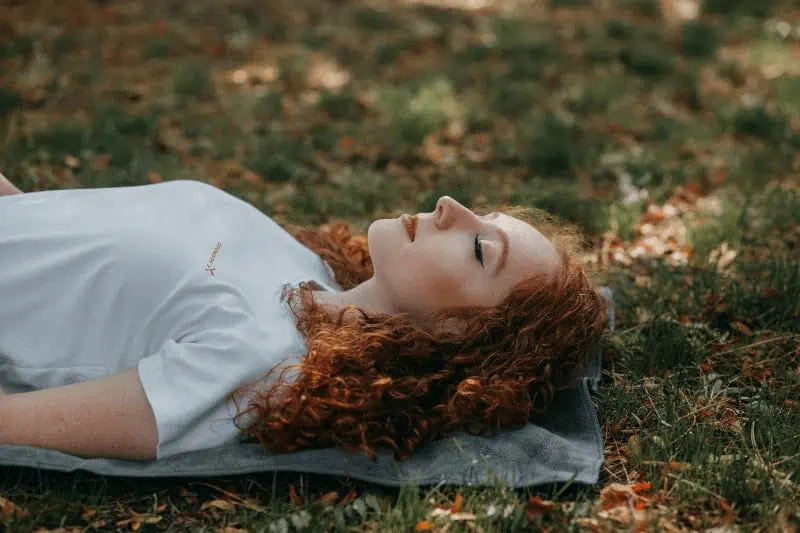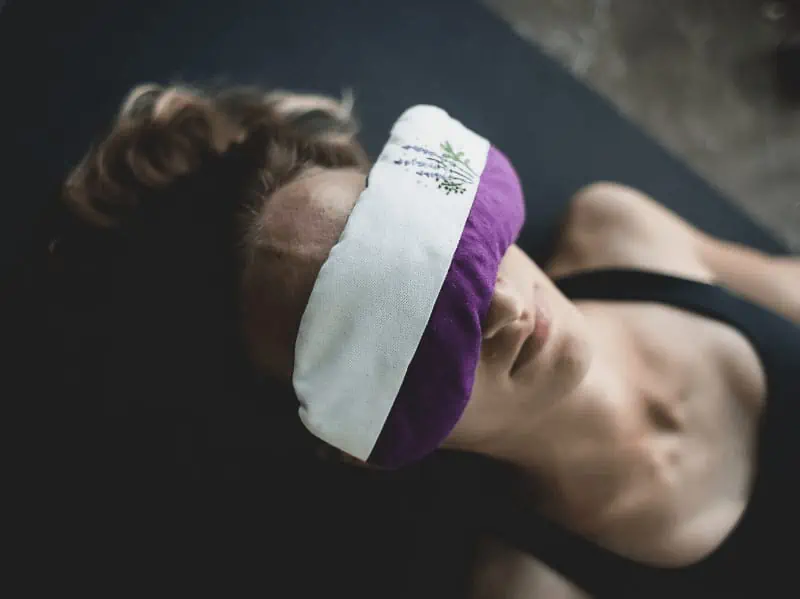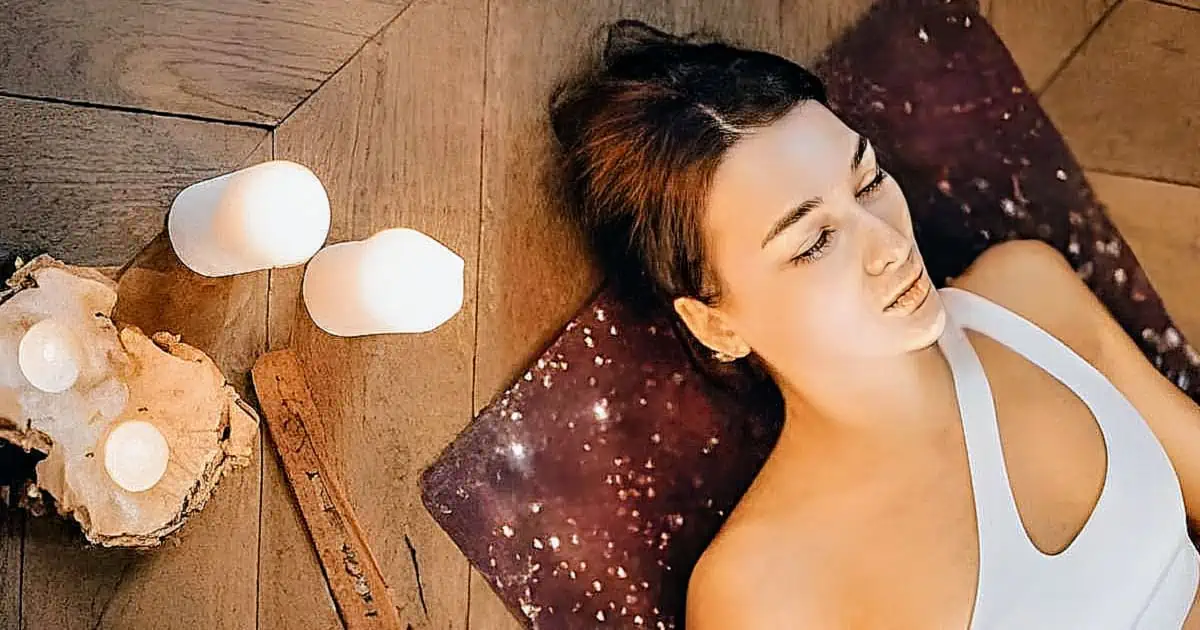Key Takeaway
Shavasana, the final resting pose in yoga, is essential for physical and mental relaxation, aiding in muscle recovery, reducing stress, and setting the stage for deeper meditation.
| SHAVASANA | |
|---|---|
| Alternate name: | Corpse Pose |
| Difficulty level: | Beginner |
| Pose category: | Restorative |
| Muscle groups: | Shavasana does not specifically activate muscle groups as it is a relaxation pose designed to relax the entire body. |
| Physical benefits: | Aids muscle recovery and tissue repair, lowers blood pressure and heart rate. |
| Therapeutic applications: | Reduces anxiety and stress levels, improves sleep quality. |
| Preparatory poses: | Balasana (Child's Pose) Supta Baddha Konasana (Reclining Bound Angle Pose) Viparita Karani (Legs-Up-the-Wall Pose) |
| Counterposes that follow well: | Fish Pose (Matsyasana) Fetal Position (Garbhasana) |
| Chakras activated: | Crown Chakra (Sahasrara) |
| Most helpful prop: |  Bolster under knees - supports lower back, enhances relaxation. See latest price |
You know that feeling when you’ve been rushing around on your feet all day, and you finally get to kick back and do nothing?
This is how every yogi feels when the instructor finally cues Shavasana after a challenging yoga class!
Shavasana is the final resting pose of a yoga practice. But unlike all the other asanas, Shavasana is about stillness and serenity.
From the outside, Shavasana may look like a pointless pose or a waste of time. But this relaxation posture brings many hidden but profound benefits.
As a yoga teacher for over five years, I am a HUGE advocate for Shavasana, and in this article, I’m explaining why.
Along with explaining why you should NEVER skip Shavasana, I’m sharing my top tips for finding inner peace and relaxation in this surprisingly tricky asana. And be sure to stay until the end as I’ll give my favorite modifications and variations, helping you master the art of conscious surrender.
Watch our recommended steps for entering, holding, and exiting the pose.
Contents
What is Shavasana?
Shavasana is a Sanskrit word that translates to ‘corpse pose.’ While the aim of the posture is not to pretend to look dead, the name relates to the still position you take, laying on your back with your arms and legs slightly open – like a corpse.
Savasana is a simple yet profound pose that marks the end of your yoga practice.
Throughout my years of teaching yoga, I’ve encountered many beginner yogis who think savasana is just lying on your mat.
But this couldn’t be further from the truth. Savasana is about relaxing the body and mind, slowing down the breath, and allowing your body to absorb the effects of your active asanas.
Rooted in Sanskrit wisdom, Shavasana is also an ancient yogic technique that invites you to explore the depth of the tranquility within, fostering deeper self-awareness and inner connection.
The Importance of Shavasana

Like all yoga poses, savasana benefits us physically, mentally, and spiritually..
Physically, Savasana balances the nervous system by calming the sympathetic nervous system (fight or flight response) and stimulating the parasympathetic nervous system (rest and digest mode).
This leads to various other physical benefits, such as:
- Aids muscle recovery and tissue repair (so you don’t feel sore after that intense crow pose!)
- Lowers elevated body temperature
- Lowers your blood pressure and slows your heart rate
The effect savasana has on the nervous system also triggers various mental health benefits, such as:
- Reduces anxiety and stress levels
- Improves concentration
- Enhances mental clarity
- Improves sleep quality
Then, spiritually, savasana can serve as a bridge from physical yoga practice to meditation. The supine posture promotes total surrender and breath awareness, which helps to release tension and slow mental activity, allowing you to access deeper states of meditation.
Finally, Savasana allows your body and mind to digest, assimilate, and adapt to all the information you gained in your asana practice.
As international yoga teacher Noah Maze explains, we move in every direction during yoga practice and load the muscular-skeletal structures in many ways. Thus, spending a few minutes in savasana gives the body time to process all that information and adapt accordingly.
Shavasana’s Role in Relaxation and Meditation
So, how exactly does savasana calm our energy and bring us into such a peaceful and relaxed state?
It’s partly to do with the anatomy of the pose. While it looks like you are just lying down, the corpse pose calls for specific positioning of each body part. By achieving the correct anatomy and alignment of the pose, you can access that truly relaxed state.
Firstly, you lay flat on your back with your pelvis grounding, cultivating a deep connection with the earth. Here, you feel safe, protected, and embraced by Mother Nature.
Then, with your arms by your side, slightly open, and palms facing up, you invite complete relaxation to your upper body. You consciously drop your shoulders away from the ears and allow them to rest on the floor to release tightness.
You also bring your legs slightly apart with the feet open and each big toe dropping towards the floor, helping to release tension in your leg muscles and relieve pressure on your spine.
Once you’ve achieved the correct pose anatomy, you bring full concentration to your body as you consciously relax each body part. With your body free from tension, you slow down your breath to reduce mental activity, allowing you to enter a deep relaxation state.
How To Practice Shavasana – Step-by-step Guide

To enjoy all the beautiful benefits of corpse pose, follow these detailed steps:
- Lie down flat on your back. Ensure your abdomen muscles are soft, shoulder blades spread, and the hip and trunk are level.
- Open your legs and arms, palms facing upwards, and fingers relaxed.
- Drop both feet out to the side with the big toes pointing towards the front of your yoga mat.
- Close your eyes and bring awareness to your chest and belly, observing your breath.
- If your breathing rate is rapid or shallow, take three slow, deep breaths, signaling to your nervous system that it is safe and can relax.
- Now, maintain a slow but natural breathing rhythm while you stay here for 5 to 10 minutes. You will likely notice your mind wandering, but each time you observe it, bring your focus back to your breathing.
- To finish your shavasana, shift your awareness back to your body by gently wiggling your fingers and toes.
- Take a full body stretch by reaching your arms overhead. Then, bend your knees and hug them to your chest.
- Rock side to side a few times to stretch your spine before rolling onto your right side, coming into a fetal position.
- Stay in this fetal position for a few breaths, then press one hand into the mat as you come up to seated. Take as long as you need to recenter and close your practice however you like, perhaps with gratitude, setting an intention for your day, or chanting Om.
Common Challenges in Shavasana
I’ve noticed most people find shavasana challenging for one of two reasons:
- Their body is too tense.
- Their mind is racing.
Physical tension
If you are dealing with physical tension, try this body scan technique:
- Scan through your body, starting with your toes, moving up to your legs, focusing on the torso, and ending with the arms and face.
- As you move through each body part, observe any pain, tension, or discomfort.
- Try to relax those body parts further by directing your breath there.
- Concentrate on each part until you feel completely relaxed.
Overactive mind
If you cannot settle in corpse pose because your mind’s racing like a hamster on a wheel, know that this is normal.
We live such fast-paced lifestyles, making switching off incredibly difficult. As soon as we come into physical stillness, our minds use it as an opportunity to plan the rest of the day, worry about yesterday’s meeting, or even replay awkward conversations from 2007!
When this happens, don’t sweat it!
Focus on your breath, following each inhale and each exhale. You can also try a breathing technique, such as inhaling slowly, holding your breath for a few seconds, then exhaling even slower.
It can also help to visualize calming images or scenarios. For example, imagine yourself in a peaceful place like a beach or a forest. Now focus on every detail – the sound of waves crashing, the birds chirping, the smell of saltwater or pine trees.
Shavasana Variations and Modifications

While savasana is one of the most accessible yoga poses, laying on your back can be uncomfortable or unsafe for some people.
Here are some ways you can modify Savasana to meet your unique needs and level:
- Pregnant women should lay on their side during savasana instead of their back.
- For those with physical conditions, try chair shavasana instead. Sit comfortably in a chair, relax, and close your eyes.
- If you experience discomfort in the lower back, place a bolster or two yoga blocks under your knees. If that doesn’t help, take a constructive rest position instead.
- If you have neck tension, place a folded blanket under your head.
- Advanced yogis can raise their legs, resting their feet on the wall or a bolster for support.
There are also little tweaks that can make a big difference to your relaxation, such as:
- Using a weighted eye pillow to block out light and promote restful sleep.
- Cover yourself with a blanket to prevent feeling cold after your body temperature drops.
Final Thoughts
Corpse pose isn’t just an optional nap at the end of your yoga session – it’s a powerful tool for relaxation and meditation.
This profound asana serves as an energy reset to relax your entire body and soothe muscular tension. Practicing shavasana can also bring calm into the chaos of everyday life, helping you find peace and clarity on those days when everything feels like too much.
So next time your instructor cues the final resting pose, resist the urge to roll up your mat and get a head start on the next item on your to-do list. Instead, give yourself permission to rest, rejuvenate, and replenish – your mind, body, and soul will thank you for it!
FAQ: Can beginners do Shavasana?
Absolutely! Beginners can and should incorporate Shavasana into their yoga routine. It’s an excellent way for newcomers to experience deep relaxation without effort or pressure.
FAQ: When should I practice Shavasana?
You should practice Shavasana at the end of your yoga session, serving as the final posture. However, as Shavasana can be incredibly relaxing for the body and mind, you may want to practice meditation or pranayama afterward.
FAQ: Is it okay if I fall asleep during Shavasana?
Falling asleep during Shavasana is common among beginners. With regular practice, however, you’ll learn how to remain conscious yet deeply relaxed.
FAQ: Can I do Shavasana without doing other yoga poses?
Yes! While traditionally practiced at the end of a yoga sequence, you can perform Shavasana on its own as a form of relaxation or meditation.
FAQ: How long should I practice Shavasana for?
I recommend practicing corpse pose for 10% of your yoga practice. For example, 6 minutes of Shavasana is ideal for a 60-minute class, whereas 3 minutes is sufficient for a 30-minute practice.


